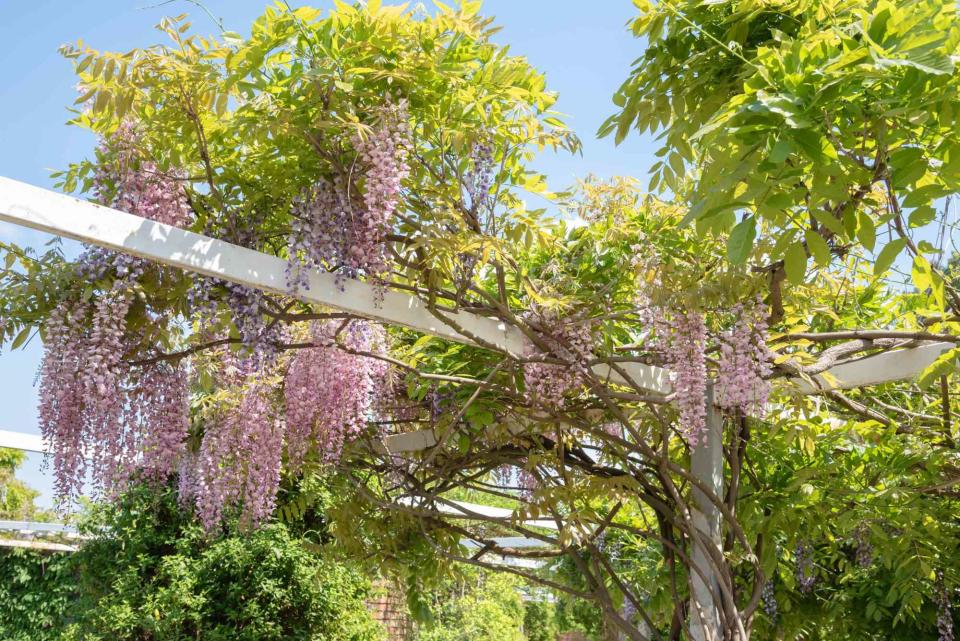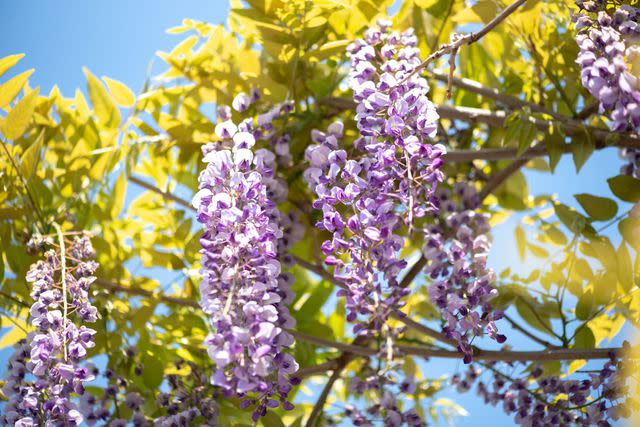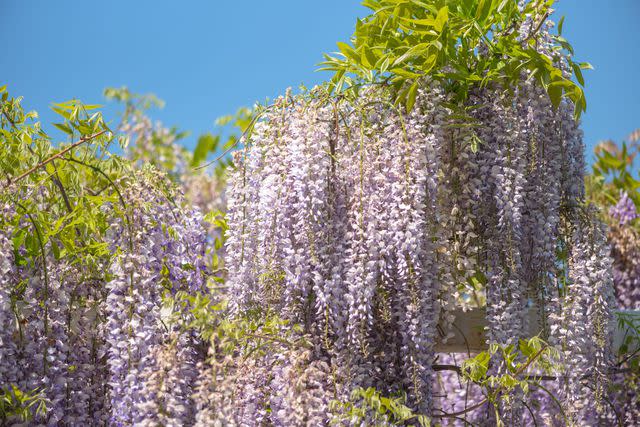How To Grow And Care For Wisteria
This romantic, blooming vine has long been a charmer in Southern gardens.

Southern Living/Evgeniya Vlasova
One day, this plant just might gobble up the South. Though it's extremely vigorous and some types are invasive, people keep planting it in their gardens. They can't resist its lovely white or purple blooms. Long clusters of pea-shaped flowers hang from trees, arbors, or anything else the vine can reach each spring. If you must plant wisteria, you may want to purchase American wisteria (W. frutescens). This native is less aggressive than Chinese wisteria (W. sinensis) or Japanese wisteria (W. floribunda). Fragrant American wisteria is native to the South from Virginia to Florida and Texas.
Wisteria is adaptable with a strong woody vine and can be grown as trees, shrubs, or vines. All have large, bright green leaves divided into many leaflets; spectacular clusters of blue, violet, pinkish, or white blossoms and velvety, pea-like pods to about six inches long in Zones 4-9. Fall color in subdued shades of yellow. According to Poison Control, wisteria is toxic to humans. It is also toxic to dogs, cats, and horses.
To get off to a good start, buy a cutting-grown, budded, or grafted wisteria; unnamed seedlings may not bloom for many years. If you start with budded or grafted plants, keep suckers removed for the first few years, or they may take over. Do not allow aggressive Asian species to grow on trees or escape into ornamental areas, as they will quickly smother the landscape. Also be wary of growing them near the house, as their muscular stems can tear apart structures.
Wisteria chains are both romantic and fragrant. But unless the homeowner is very careful, the vine's grasp will subject the house to more than an innocent crush. Luckily, there are many different kinds of wisteria, and there are safe ways to enjoy its beauty around the garden and home, while still keeping it in check. Here is everything you need to know.

Southern Living/Evgeniya Vlasova
Wisteria Fast Facts
Common Name | Wisteria, Chinese wisteria, Japanese wisteria, American wisteria, Kentucky wisteria |
Botanical Name | Wisteria spp. |
Family | Fabaceae |
Plant Type | Deciduous, perennial vine |
Mature Size | 10 to 40 feet long, 4 to 8 feet wide |
Sun Exposure | Full sun, partial shade |
Soil Type | Well-drained |
Soil pH | Acidic <6.0 |
Bloom Time | Spring |
Flower Color | Purple, white, pink, blue |
Hardiness Zones | Zone 4-9 (USDA) |
Native Area | Northern Hemisphere |
Toxicity | Toxic to humans, dogs, cats, and horses |
Wisteria Care
No doubt you've admired this beautiful plant with its chains of pendant blooms hanging from pergolas and porches. It's a Southern favorite. Wisteria has a large twisting vine that needs sturdy support to grow, and we do mean sturdy. Weak structures will give way under the weight of this heavy plant as it matures. Before planting it near your house, consult a contractor to ensure your porch can support the plant. The Japanese and Chinese varieties of wisteria are invasive. That's why many North Americans prefer to grow American wisteria, because this plant is not as aggressive and will require less maintenance.

Southern Living/Evgeniya Vlasova
Light
Wisteria prefers full sun, but in Zone 8, it benefits from some afternoon shade.
Soil
Wisteria isn't picky about the type of soil, but it does need good drainage.
Water
If you wonder how to water wisteria, you'll be glad to know it doesn't need any fussy care. Once established, it should be happy with rainfall and occasionally watering during summer and fall.
Temperature and Humidity
Wisteria will grow well in Zones 4-9. Wisteria can grow in Zone 9, but any further south than that, the climate is too hot and humid.
Fertilizer
Wisteria takes nitrogen from the air and converts it for their growth, so don't fertilize them with nitrogen. Instead, use a fertilizer high in phosphorus in the spring.
Types of Wisteria
American and Asian wisteria often look so similar that it's difficult to distinguish between them, but one identifying feature is the pods. Those of Asian type are covered in fuzz; those of the American type are smooth. While the Asian wisterias are similar in appearance to the American, there are important differences to consider before deciding which type to grow.

Southern Living/Evgeniya Vlasova
Silky Wisteria (Wisteria brachybotrys)
This variety of wisteria is native to Japan and blossoms are large, white flowers in four to six-inch clusters. When grown in tree form, mature wisteria plants bloom profusely. The following are popular silky wisteria:
'Alba' is the most commonly sold form; it bears pure white (sometimes double) flowers with yellow markings. Hardy in Zones 5–9. Grows 10–40 ft tall and 4– 30 ft wide.
'Okayama' has faintly scented deep mauve blossoms.
Japanese Wisteria (Wisteria Floribunda)
This variety of wisteria is also native to Japan and arrived in the United States in the early 19th century. This wisteria blooms purple or purple-blue flowers. The following selections are popular Japanese wisteria:
'Multijuga' has long clusters of violet flowers.
'Longissima Alba' bears two-foot clusters of white blossoms; 'Ivory Tower' is similar.
'Violacea Plena' sports very full clusters of double, deep violet-blue flowers.
Chinese Wisteria (Wisteria Sinensis)
This variety is native to China, and like the Japanese wisteria, an invasive grower when left unchecked. Violet-blue, fragrant flowers appear before leaf out and come in shorter clusters.
'Alba' has white flowers.
'Cooke's Special' is a grafted form with blue-purple flowers 18 inches long.
'Caroline', probably a hybrid, blooms early and is highly fragrant.
American Wisteria (Wisteria Frutescens)
This variety of wisteria is native to the South, from Virginia to Florida and Texas. This variety is smaller than the Asian varieties and blooms a little later. It grows less vigorously than the Japanese (Wisteria floribunda). The American wisteria is mildly fragrant with pale lilac flowers resembling grape clusters. The following selections are popular American wisteria:
'Amethyst Falls' has vivid lilac-blue flowers.
'Nivea' blooms in spring and summer and features delightful white blooms.
Kentucky Wisteria (Wisteria Macrostachya)
This variety of wisteria is native from Illinois to Texas and is a good choice for smaller gardens. This variety blooms among new leaves in late spring. Mildly fragrant flowers bloom in light blue to violet or blue-purple and grow eight to 12 inches long. The Kentucky wisteria is less aggressive, making it an easier plant to grow. Some popular selections of Kentucky wisteria include:
'Clara Mack' has white flowers.
'Bayou Two O’Clock' has blue-violet flowers held in long, pointed blooms..
'Pondside Blue' bears pale blue-violet blossoms.
Pruning Wisteria
The South's most seductive vine, wisteria makes us swoon one week and swear the next. The key to success is curbing its enthusiasm, says Steve Bender, also known as the Grumpy Gardener. Wisteria will require pruning to keep it in check, and you'll need to do it about twice a year, on no particular schedule. Cut back its runners. Some dedicated Southern gardeners who want to spend the time, find ways to prune wisteria into trees with a gorgeous canopy or shrubs.

Southern Living/Evgeniya Vlasova
Bender believes there are few sights are as beautiful as wisteria trained along the roofline and railings of a Southern home. But this requires a maintenance service to prune the vine about every two weeks in summer or your gutters and railings will be ruined. Fortunately, there's a way to train wisteria along the top of a ground-floor porch safely. Run a metal pole from one porch post to another about 18 inches below the crossbeam. Let the vine's branches and runners twine only around the pole. Once flowering finishes, you'll need to prune the vine regularly if you still want to see off the porch. Wisteria is also gorgeous on an arbor, where you can let the vine climb a corner post to the top. Then tie it to the arbor. Train it so most of its branches and runners lie atop the arbor and wrap around themselves rather than the posts and rafters.
Overwintering Wisteria
No special steps are required to winterize it. Wisteria is a hardy plant south of Zone 5.

Southern Living/Evgeniya Vlasova
Frequently Asked Questions
How Do I Remove an Invasive Wisteria?
Removing this deep-rooted plant requires persistence, says Bender. Start by sawing off all vines down to the base. You can also paint the end of each stump with an herbicide like Roundup (do this within five minutes of making each cut, or the herbicide won't be absorbed). No matter what, expect more shoots to pop up from the long roots, sometimes over several seasons. But don't despair: As long as you keep removing growth to starve the plant, it will eventually die, opening up space for other plants that play nice in the garden.

Southern Living/Evgeniya Vlasova
How Tall Are Wisteria When Mature?
Wisteria varieties can grow for years, reaching over 40 feet tall. On roadsides in the South, you'll find them vining to the top of the tallest trees.
How Does Wisteria Spread?
The plant climbs and vines above ground, but that's not all. Asian wisterias spread as the roots produce suckers far from the original plant. Wisteria also drops seeds.
For more Southern Living news, make sure to sign up for our newsletter!
Read the original article on Southern Living.

